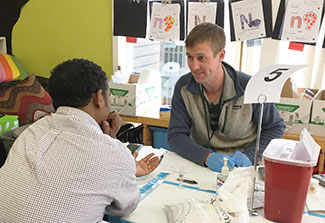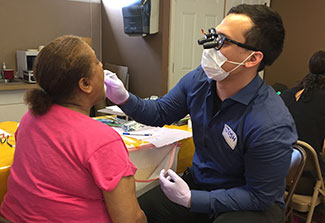NIH studies global-to-local solutions for HIV/AIDS stigma
November / December 2020 | Volume 19, Number 6

Photo courtesy of Dr. Rena Patel/project Harambee
A number of interventions to reduce HIV stigma in Africa have
been adapted for use in the U.S., including this health fair in
Seattle that increased HIV testing in an African immigrant
community by 50%.
Stigma remains an enormous barrier to controlling the HIV/AIDS epidemic in many parts of Africa, as well as in underserved areas of the U.S. A number of successful interventions developed in Africa and tailored for use in the U.S. were discussed during a recent webinar hosted by Fogarty and the NIH Office of Behavioral and Social Sciences Research (OBSSR).
This
global-to-local approach will be explored in a series of webinars to share lessons learned on a variety of topics. “Our goal is to encourage both funders and researchers to give serious consideration into how global health research findings could be adapted for use in the U.S,” according to Fogarty senior scientist Dr. Linda Kupfer. “Although global-to-local research transfer is not new, we hope to investigate this topic somewhat differently by focusing on the type of research methods that have been used successfully.”
There are similar barriers for access to health care among those living in Eldoret, Kenya and Austin, Texas, observed Dr. William Tierney, who has conducted research in both locations. Poverty, lack of transportation and unreliable cellphone communication all pose significant challenges in both populations, which makes combatting the HIV/AIDS epidemic difficult.
“If you want to break the back of the HIV epidemic you have to get out into the community,” noted Tierney, a former Fogarty grantee and professor at the University of Texas at Austin. A successful program that conducted home visits for 2 million Kenyans - providing testing for HIV, pregnancy and blood glucose levels - was adapted for use in a low-income neighborhood in Austin. The initiative also helps clients navigate the health care system and provides referrals to food banks and other community resources.

Photo courtesy of Dr. Rena Patel/project Harambee
A health fair designed to increase screening for HIV and other
health conditions among an African immigrant community in
Seattle also offered dental care.
Given that AIDS is the leading cause of death for African American women aged 25-34, researchers at the University of Washington (UW) studied how they could reduce HIV stigma to better meet the needs of this population. They found solutions in a toolkit developed by the International Center for Research on Women that was successfully used in Africa, according to UW’s Dr. Deepa Rao. The resource provides materials for a variety of flexible approaches to spur conversations including warm-up games, case studies, role playing and other exercises.
In NIH-funded pilot testing, the program was found to be feasible and acceptable in U.S. communities. Videos designed to trigger difficult conversations were added and found to be effective. The program was also adjusted for use in men.
Researchers at the University of Alabama at Birmingham (UAB) also used components of the Africa toolkit in their efforts to reduce HIV stigma locally. “Stigma experiences have many commonalities at their core across the globe,” observed UAB’s Dr. Janet Turan. She and her team added a module on intersectional stigma, encouraging program participants to explore identity issues related to race, poverty, religion and sexual orientation. “Everybody has a story to share on that and it’s a very powerful exercise,” said Turan. With proof of concept from their successful pilot, they are now scaling up in Alabama and Tennessee as well as using Fogarty funding to adapt the intervention for use in the Dominican Republic.
Finally, another UW team used a community health fair approach to increase screening for HIV and other diseases among African immigrant communities in the Seattle area. African-born individuals account for 2% of population but receive 10% of the county’s new HIV diagnoses. Given immigration sensitivities, it was not feasible to go door-to-door, so mini-health fairs were held in residential complexes to provide screening for HIV, hypertension, diabetes, cholesterol and obesity, in addition to providing dental care and other services. The result was a 50% uptake in HIV testing, according to UW’s Dr. Rena Patel.
Fogarty is interested in continuing to collect case studies of global-to-local transfer of innovations and interventions. Please send submissions to
arianne.malekzadeh@nih.gov.
More Information
-
"Global-to-Local" Webinar Series
hosted by Fogarty and co-hosted by NIH partners - NIH Notice:
Learning from the Transfer of HIV Interventions from Low- and Middle-Income Countries (LMICs) to the United States: Informing the Plan for America to End the HIV Epidemic (NOT-TW-19-008), released December 18, 2019
- Project:
Science of Stigma Reduction: New Directions for Research to Improve Health
coordinated by Fogarty's Center for Global Health Studies (CGHS) - Toolkit:
Understanding and Challenging HIV Stigma Toolkit for Action
International Center for Research on Women (ICRW), 2003 -
International Conference on Stigma
- Related publications:
-
Adaptation and implementation of an intervention to reduce HIV-related stigma among healthcare workers in the united states: piloting of the FRESH workshop
AIDS Patient Care and STDs, November 1, 2016 -
Harambee!: A pilot mixed methods study of integrated residential HIV testing among African-born individuals in the Seattle area
PLOS ONE, May 6, 2019 -
Stigma reduction among African American women with HIV: UNITY health study
JAIDS, July 1, 2018 -
Feasibility, acceptability, and preliminary efficacy of the unity workshop: An internalized stigma reduction intervention for African American women living with HIV
AIDS Patient Care and STDs, October 1, 2012
To view Adobe PDF files,
download current, free accessible plug-ins from Adobe's website.
Related Fogarty Programs
Related World Regions / Countries
Related Global Health Research Topics